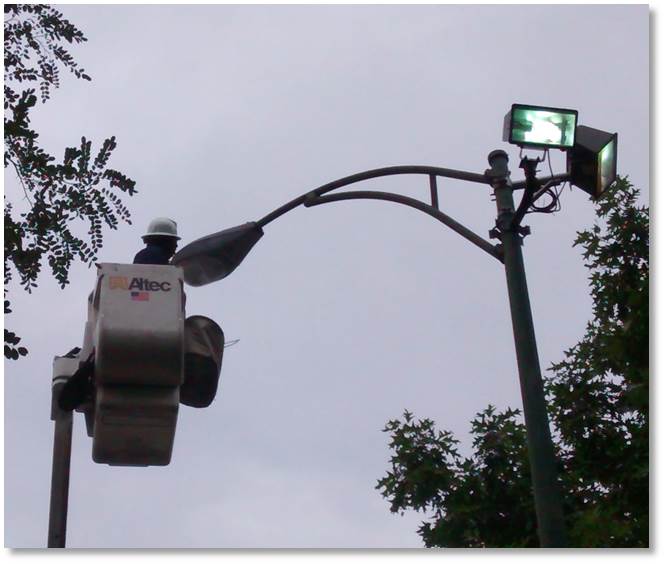By Brian Buckley | Mon, March 23, 15
-
CLICK HERE to access a March 2015 webinar recording featuring LED Street Lighting Conversion Strategies, feauturing a case study of Pittsburgh, Pennsylvania.
Certain elements of our community’s infrastructure often go unnoticed, residing in the background of our increasingly busy lives. Think about it. How much time do you take out of your day to dwell on the importance of paved roads, the complex web of sprawling power lines, or the endless rows of fixtures that spill light onto our streets at night? These often-overlooked facets of our communities are crucial to the smooth operation of life as we know it, and many of them, street lights in particular, can be retrofitted and connected to improve the quality of our lives in a myriad of ways.
Working in partnership with the U.S. Department of the Energy, NEEP recently took a closer look at the energy saving opportunity street lighting presents – in LED Street Lighting Assessment and Strategies for the Northeast and Mid-Atlantic we present the barriers that stand in the way of widespread conversion and propose a series of strategies and policy recommendations to get the region on track to realizing the significant cost and energy savings street lighting presents. We discovered that many jurisdictions in the Northeast/ Mid-Atlantic region are beginning to view their street lights—which often account for more than 20 percent of municipal electricity usage—as an opportunity for dramatic cost savings and energy usage reductions. While most municipalities still use high pressure sodium (HPS) or metal halide lighting to illuminate their streets, recent advancements in solid state “LED” technologies offer the potential for increased reliability, as well as much better lumen-per-watt efficiency. These modern fixtures also help reduce light pollution by shining light where it’s needed for safety and sending less into the nighttime sky. Across the region municipal energy efficiency programs, such as the Massachusetts Green Communities Initiative, often explore LED street light conversion as a primary step for attaining municipal energy efficiency goals. The 2015 Regional Roundup of Energy Efficiency Policy takes a broad look at policy developments and opportunities, including the opportunity to realize significant savings through street lighting conversions.

While street lighting may seem like an easy and highly visible way to reach savings goals, the region faces many barriers impeding widespread deployment of LED street lights. In some cases, key decision-makers lack the expertise needed to conduct a conversion. In others, high upfront costs and undepreciated legacy lighting equipment impede broad adoption of newer technologies. Most importantly, regulatory lag and the delayed utility adoption of LED tariffs have impeded widespread conversion to LED technologies.
For example, if a utility doesn’t offer an LED street lighting rate within its electric service delivery tariff, LED technologies are unavailable to the municipalities it serves. This barrier is compounded by the typical timeline for a major tariff revision, which can take up to a year and often occurs only once every one to three years. As utilities revise their tariffs, the widespread adoption of LED street lighting will hinge upon whether rates for LED fixtures are offered and, more specifically, whether the LED rates provide municipalities a financial advantage over incumbent HPS technologies.
In spite of the above-mentioned technical, regulatory, and financial challenges, several recent developments in our region highlight the field as ripe for movement away from outdated technologies toward LEDs:
LED Tariff Offerings:
Approximately one third of the region’s utilities now offer tariffs that provide a rate for company-owned LED fixtures. These include: United Illuminating, , Delmarva Power, Central Maine Power, Baltimore Gas and Electric, Potomac Edison, Unitil, Atlantic City Electric, Rockland Electric Company, Orange and Rockland Utilities, Duquesne Light and Power, Pike County Electric, Green Mountain Power, and two Eversource companies: Eversource CT Electric and Eversource New Hampshire. Notably, the Eversource New Hampshire tariff (rate EOL) is a “customer contributed” tariff, allowing a municipality to purchase their own LED street lighting fixtures for contribution to the utility. This “customer contributed” model is important because it allows a municipality who currently leases their fixtures from the utility to engage a third party performance contractor to perform an LED conversion.
Growing Public Awareness:
LED street light conversion projects in large cities like New York, Philadelphia, and Boston have drawn the attention of many, and outlined the business case for conversion. Even more notably, smaller municipalities in Connecticut and Massachusetts have joined together to pursue LED conversion strategies. To share best practices and promote awareness, some communities in our region — including Portland, Maine — have committed to joining the U.S. DOE’s High Performance Outdoor lighting Accelerator.
Legislative Action:
To circumvent regulatory barriers to adoption, legislation in Massachusetts, Maine, Maryland and Rhode Island has enabled municipal purchase of utility-owned street lights, while public utility commissions in Connecticut and Vermont have also set precedents for such purchases. Just as importantly, legislatures in Vermont and Rhode Island have enacted laws to alter tariffs requiring investor owned utilities to offer an LED street lighting option for municipalities.
Dramatic Price Drops:
As technology has rapidly improved and more players enter the market, an LED street light that cost $432 in 2009 cost just $141 in 2013. In fact, trusted manufacturers now offer LED streetlights at the 100 watt HPS equivalent lumen level for under $100.
These, and other recent developments within the field highlight our region as ripe for movement away from legacy technologies and toward LED street light conversions. To learn more about street lighting opportunities and hear about the recent Presidential Challenge for Advanced Outdoor Lighting, visit the Department of Energy’s Better Buildings Challenge website. For more information on LED product performance testing, visit the website of NEEP’s DesignLights Consortium.
